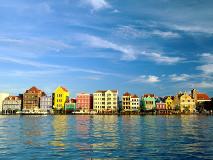|
 The traditions of the black Curaçaoan population have survived for centuries.
A majority of the islands most musical forms can be traced directly back to Africa.
A good example is Tambu, the basic instruments are the drum and the chapí.
Tambu is one of the most vibrant cultural expressions of Curaçaoan the people.
Tambu parties were usually limited to a few weeks at the end of the year.
The beginning of each new year marks also a vibrant cultural expression.
The annual Carnival festivities, you will be bombarded with the catchy
beat of the Carnival Tumba. The Tumba is the islands most popular dance tune,
and is every bit as important to Curaçaoans as salsa is to Latin Americans.
The traditional rhythms of Curaçao's harvest festival, the Seú, live on
today only in the annual folklore parade that is held in the city of Willemstad
the day after Easter. Seú's basic instruments are drums and chapí's and blew on hollowed
out cow's horns or conch shells. An other traditional Curaçaoan music instrument
is the "kaha di òrgel" (barrel organ). The organ grinder is usually accompanied
by someone playing the wiri. The barrel organ, originally from Germany, came
to the island via Venezuela at the end of the 19th century.
The traditions of the black Curaçaoan population have survived for centuries.
A majority of the islands most musical forms can be traced directly back to Africa.
A good example is Tambu, the basic instruments are the drum and the chapí.
Tambu is one of the most vibrant cultural expressions of Curaçaoan the people.
Tambu parties were usually limited to a few weeks at the end of the year.
The beginning of each new year marks also a vibrant cultural expression.
The annual Carnival festivities, you will be bombarded with the catchy
beat of the Carnival Tumba. The Tumba is the islands most popular dance tune,
and is every bit as important to Curaçaoans as salsa is to Latin Americans.
The traditional rhythms of Curaçao's harvest festival, the Seú, live on
today only in the annual folklore parade that is held in the city of Willemstad
the day after Easter. Seú's basic instruments are drums and chapí's and blew on hollowed
out cow's horns or conch shells. An other traditional Curaçaoan music instrument
is the "kaha di òrgel" (barrel organ). The organ grinder is usually accompanied
by someone playing the wiri. The barrel organ, originally from Germany, came
to the island via Venezuela at the end of the 19th century.
Rich as Curaçao's musical heritage is, local music continues to develop. Composers
draw on the many influences on local culture to create their own syntheses.
The numerous local bands freely combine salsa, merengue, zouk, reggae, tumba,
tambu, and almost anything else you can dance to. You can expect to hear
all these at local radios and clubs, as well as the latest American tunes
specially R&B and Rap/Hip Hop. One thing is for sure, Curaçaoans are great fans
of music and sure love to dance.
Here is a sample:
|
950KB

|
|
|
|
|